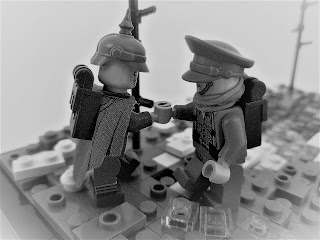March 6, 1916
 General Falkenhayn, now too invested in the offensive to admit it a failure, launched another massive attack. This time, it was directed at the French artillery bombarding the advancing German forces from the west side of the Meuse River. However, the German forces were unable to reach their objective. Instead, their advance bogged down in their attempt to take a ridge spanning from Le Mort Hommes to Côte 304, which was directly in their path. This highly contested ridge was fought over for weeks until the Germans finally took it in May, after an artillery bombardment so intense, it reduced the height of the ridge by 25 feet in some places. After this short victory, the Germans advanced forward, only to meet the next line of French defenses.
General Falkenhayn, now too invested in the offensive to admit it a failure, launched another massive attack. This time, it was directed at the French artillery bombarding the advancing German forces from the west side of the Meuse River. However, the German forces were unable to reach their objective. Instead, their advance bogged down in their attempt to take a ridge spanning from Le Mort Hommes to Côte 304, which was directly in their path. This highly contested ridge was fought over for weeks until the Germans finally took it in May, after an artillery bombardment so intense, it reduced the height of the ridge by 25 feet in some places. After this short victory, the Germans advanced forward, only to meet the next line of French defenses.
On the allied front, things weren't going too well, either. General Joseph Joffre was not a fan of Pétain's more defensive leniency, and soon decided enough was enough. He knew he couldn't outright dismiss him, as Pétain had become a national hero after his heroic defense of Verdun. Subsequently, Joffre promoted him to a higher position that took him away from the front lines, then bringing in officers who shared in his belief of attack over defense.
Thus, the battle for Verdun became a bloody cycle of vicious attacks to costly counterattacks once again. Fort Douaumont, a point of pride for the French, was heavily fought over. It quickly turned to a killing ground for French and Germans alike. The battle also spread to the skies where the
first dogfights of the war took place. The French held the upper hand in that arena, while the Germans largely controlled the ground battle. On June 7th, they took the French-held Fort Vaux after a week of brutal fighting within its cavernous hallways. A month later, they advanced as far as just three miles from Verdun. By then, however, their attack had once again stalled.
This time it was the allied summer offensives that were being launched elsewhere. The Russian Brusilov Offensive in June forced the Germans to transfer some of their troops from Verdun to assist at the eastern front, weakening their forces fighting against the French defenders. Then, in July, when the British-led Somme Offensive was launched, keeping the German presence at Verdun went from difficult to impossible. With the German army now severely weakened, it was now France's turn to go on the offensive.
Over the following months, France began to slowly take back the ground lost early on in the German attack. Fort Douaumont was recaptured on October 24th, while Fort Vaux was retaken November 2nd. By December 18th, when the offensive officially ended, the French had nearly advanced to the positions they had held before the battle began. The dead numbered 300,000. The great offensives of 1916 had finally come to an end.














.jpg)
.jpg)






.jpg)
